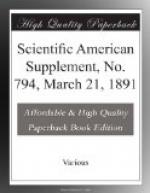* * * * *
THE MANUFACTURE AND USE OF PLASTER OF PARIS.
It has long been a familiar fact that gypsum yields on baking a material which possesses the power of setting with water to a firm mass, this setting being accomplished much more quickly than is the case with mortar.
The explanation of the setting of plaster was first given by Lavoisier, who pointed out that gypsum is an hydrated salt, and that the set plaster is in fact gypsum reformed, the change brought about by baking being merely loss of water of crystallization. The beds of gypsum of most importance both formerly and at the present time in the plaster manufacture occur in the neighborhood of Paris in the lower tertiary formation. Different beds differ (1) in respect of character and quantity of admixed materials and (2) in the structure of the gypsum itself. With regard to the first point, some deposits contain a notable proportion of carbonate of lime, a fact which under certain circumstances may considerably influence the character of the plaster. In the matter of structure two principal varieties occur (1) granular and (2) fibrous. Further, hardness of the granular kind varies considerably. These differences of structure in the original material appear to exercise an influence on the properties of the plaster. Thus according to Payen the plaster formed from the granular variety sets more gradually than that derived from the fibrous, and forms a denser mass. The softer kinds of the granular gypsum are those principally used in the production of plaster for the moulds of potteries.
In the old fashioned process which is still employed for making the common kinds of plaster, the material is exposed to the direct action of flame. Large lumps are placed in the lower part of the furnace, above them smaller lumps, and, after the heating has been carried on for some time, finely divided material is filled in at the top. The outer portion of the larger lumps is always overburnt, and in the upper part of the furnace the presence of shining crystalline particles generally indicates the fact that some gypsum has remained unchanged. Provided that the amount of unburnt and overburnt material does not exceed about 30 per cent. of the total, the plaster is suitable for many applications.
It was early observed that set plaster could be revivified by a second baking, but attempts in this direction were not uniformly successful, it being found that the dehydrated substance in some cases refused to set with water. It behaved in fact similarly to the natural anhydrous calcium sulphate which is unaffected by water. These failures were found to be due to the employment of too high a temperature, and such plaster was termed dead burnt. Although this fact was ascertained long ago, yet ignorance of what had already been done has probably been the cause of many disappointments in attempts at revivification which have been made from time to time by persons unacquainted with the history of the subject.




